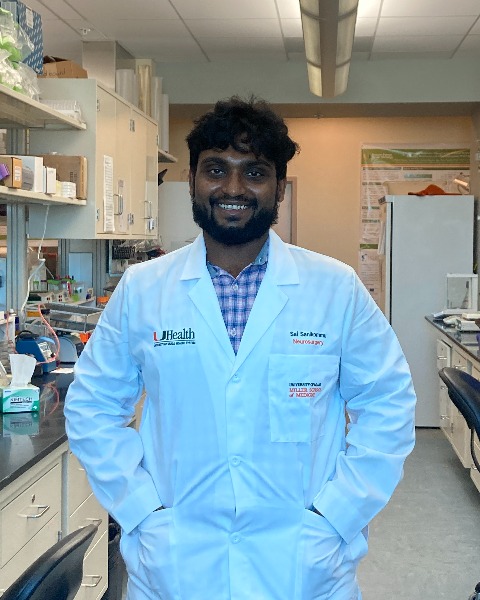Cerebrovascular
mTOR inhibition induces mesenchymal stem cells differentiation into vascular smooth muscle cells
Mtor Inhibition Induces Mesenchymal Stem Cells Differentiation into Vascular Smooth Muscle Cells

Sai Sanikommu, MD
Research fellow
University of Miami
Miami, Florida, United States
Presenting Author(s)
Introduction: Intracranial aneurysms (ICA) rupture is the most common cause of subarachnoid hemorrhage. Vascular smooth muscle cell (VSMC) and endothelial cell (EC) dysfunction play important roles in ICA formation and rupture. Mesenchymal stem cells (MSCs) are known for their self-renewal and differentiating into new cell types. The mammalian target of rapamycin (mTOR) plays an important role in diverse cellular functions, including anabolic and regulatory pathways inside the cells. Rapamycin, a mTOR complex one specific inhibitor, is clinically used for various cardiac and vascular pathologies. In this study, we explored MSCs potential to express VSMC markers under the influence of rapamycin.
Methods: Human MSCs are treated with rapamycin at 10ng/ml for 2 days, 5 days, and 10 days. Western blotting and qRT-PCR were done to check the expression of VSMC markers. Calcein-AM staining was used to determine cell viability, morphology, and tube formations. Statistical analysis was performed using one-way ANOVA followed by Tukey's post hoc test for multiple comparisons or Student's t-test for comparing two groups.
Results: MTT and Calcein-AM analysis demonstrate that rapamycin treatment reduced MSC proliferation but did not affect cell viability. Rapamycin treatment also induced changes in MSC morphological shape, resulting in a threefold increase in cell area compared to controls (p < 0.04). VSMC markers, αSMA and transgelin expression was significantly increased by rapamycin treatment at both 5 days (αSMA, 2.2-fold, p < 0.009) (transgelin, 1.4-fold, p< 0.003) and 10 (αSMA, 2.5-fold, p < 0.0001) (transgelin, 1.85-fold, p< 0.02) and persistent even after the withdrawal of rapamycin for 8 days. Rapamycin was also found to induce VEGFA expression, a known promoter of angiogenesis. VEGFA expression correlated with the formation of tube-structures connecting adjacent cells.
Conclusion : These results demonstrate the potential to induce VSMC proteins and EC features in MSCs treated with rapamycin, which may allow for improved healing of ICA and a reduction in rupture risk.
Methods: Human MSCs are treated with rapamycin at 10ng/ml for 2 days, 5 days, and 10 days. Western blotting and qRT-PCR were done to check the expression of VSMC markers. Calcein-AM staining was used to determine cell viability, morphology, and tube formations. Statistical analysis was performed using one-way ANOVA followed by Tukey's post hoc test for multiple comparisons or Student's t-test for comparing two groups.
Results: MTT and Calcein-AM analysis demonstrate that rapamycin treatment reduced MSC proliferation but did not affect cell viability. Rapamycin treatment also induced changes in MSC morphological shape, resulting in a threefold increase in cell area compared to controls (p < 0.04). VSMC markers, αSMA and transgelin expression was significantly increased by rapamycin treatment at both 5 days (αSMA, 2.2-fold, p < 0.009) (transgelin, 1.4-fold, p< 0.003) and 10 (αSMA, 2.5-fold, p < 0.0001) (transgelin, 1.85-fold, p< 0.02) and persistent even after the withdrawal of rapamycin for 8 days. Rapamycin was also found to induce VEGFA expression, a known promoter of angiogenesis. VEGFA expression correlated with the formation of tube-structures connecting adjacent cells.
Conclusion : These results demonstrate the potential to induce VSMC proteins and EC features in MSCs treated with rapamycin, which may allow for improved healing of ICA and a reduction in rupture risk.

.jpg)